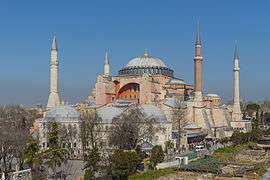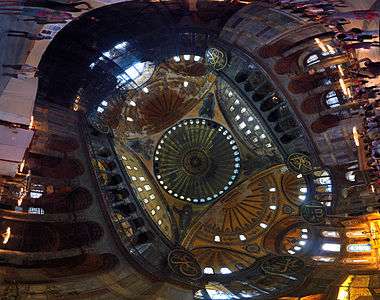Isidore of Miletus

Isidore of Miletus (Greek: Ἰσίδωρος ὁ Μιλήσιος; Medieval Greek pronunciation: [iˈsiðoros o miˈlisios]; Latin: Isidorus Miletus) was one of the two main Byzantine Greek architects (Anthemius of Tralles was the other) that Emperor Justinian I commissioned to design the cathedral Hagia Sophia in Constantinople from 532 to 537. The creation of an important compilation of Archimedes' works has been attributed to him.[1] The spurious Book XV from Euclid's Elements has been partly attributed to Isidore of Miletus.[2]
Biography


Isidore of Miletus was a renowned scientist and mathematician before Emperor Justinian I hired him. Isidorus taught stereometry and physics at the universities, first of Alexandria then of Constantinople, and wrote a commentary on an older treatise on vaulting.[3] Eutocius together with Isidore studied Archimedes work.[4] Isidore is also renowned for producing the first comprehensive compilation of Archimedes' work, the Archimedes palimpsest survived to the present.
Hagia Sophia
Emperor Justinian I appointed his architects to rebuild the Hagia Sophia following his victory over protesters within the capital city of his Roman Empire, Constantinople. The first basilica was completed in 360 and remodelled from 404 to 415, but had been damaged in 532 in the course of the Nika Riot, “The temple of Sophia, the baths of Zeuxippus, and the imperial courtyard from the Propylaia all the way to the so-called House of Ares were burned up and destroyed, as were both of the great porticoes that lead to the forum that is named after Constantine, houses of prosperous people, and a great deal of other properties.”[5]
The warring factions of Byzantine society, the Blues and the Greens, opposed each other in the chariot races at the Hippodrome and often resorted to violence. During the Nika Riot, more than thirty thousand people died.[6] Emperor Justinian I ensured that his new structure would not be burned down, like its predecessors, by commissioning architects that would build the church mainly out of stone, rather than wood, “He compacted it of baked brick and mortar, and in many places bound it together with iron, but made no use of wood, so that the church should no longer prove combustible.”[7]
Isidore of Miletus and Anthemius of Tralles originally planned on a main hall of the Hagia Sophia that measured 70 by 75 metres (230 x 250 ft), making it the largest church in Constantinople, but the original dome was nearly 6 metres (20 ft) lower than it was constructed, “Justinian suppressed these riots and took the opportunity of marking his victory by erecting in 532-7 the new Hagia Sophia, one of the largest, most lavish, and most expensive buildings of all time.”[8]
Although Isidore of Miletus and Anthemius of Tralles were not formally educated in architecture, they were scientists that could organize the logistics of drawing thousands of labourers and unprecedented loads of rare raw materials from around the Roman Empire to create the Hagia Sophia for Emperor Justinian I. The finished product was built in admirable form for the Roman Emperor, “All of these elements marvellously fitted together in mid-air, suspended from one another and reposing only on the parts adjacent to them, produce a unified and most remarkable harmony in the work, and yet do not allow the spectators to rest their gaze upon any one of them for a length of time.”[9]
The Hagia Sophia architects innovatively combined the longitudinal structure of a Roman basilica and the central plan of a drum-supported dome, in order to withstand the high magnitude earthquakes of the Marmara Region, “However, in May 558, little more than 20 years after the Church’s dedication, following the earthquakes of August 553 and December 557, parts of the central dome and its supporting structure system collapsed.”[10] The Hagia Sophia was repeatedly cracked by earthquakes and was quickly repaired. Isidore of Miletus’ nephew, Isidore the Younger, introduced the new dome design that can be viewed in the Hagia Sophia in present-day Istanbul, Turkey.
After a great earthquake in 989 ruined the dome of Hagia Sophia, the Byzantine officials summoned Trdat the Architect to Byzantium to organize repairs. The restored dome was completed by 994.[11]
References
- ↑ Reviel Netz (2004). "The Works of Archimedes: Volume 1, The Two Books On the Sphere and the Cylinder: Translation and Commentary".
- ↑ Boyer (1991). "Euclid of Alexandria". A History of Mathematics. pp. 130–131).
- ↑ Krautheimer,page 215
- ↑ Alan Cameron (1990). "Isidore of Miletus and Hypatia: On the Editing of Mathematical Texts". p. 127.
- ↑ Prokopios, page 138
- ↑ Prokopios, page 144
- ↑ Mango, page 78
- ↑ Watkin, page 76
- ↑ Mango, page 75
- ↑ Cakmak, page 693
- ↑ Maranci, pages 294–305
Sources
- Cakmak, AS; Taylor, RM; Durukal, E (2009). "The Structural Configuration of the First Dome of Justinian's Hagia Sophia (AD 537-558): An Investigation Based on Structural and Literary Analysis". Soil Dynamics and Earthquake Engineering. 29 (4).
- Krautheimer, Richard (1965). Early Christian and Byzantine Architecture. Baltimore: Penguin Books. ISBN 978-0-300-05294-7.
- Mango, Cyril A. (1972). The Art of the Byzantine Empire, 312-1453: Sources and Documents. Englewood Cliffs, New Jersey: Prentice-Hall. ISBN 0-8020-6627-5.
- Maranci, Christina (September 2003). "The Architect Trdat: Building Practices and Cross-Cultural Exchange in Byzantium and Armenia". The Journal of the Society of Architectural Historians. 62 (3): 294–305. doi:10.2307/3592516.
- Prokopios (2010). Anthony Kaldellis, ed. The Secret History: With Related Texts. Indianapolis: Hackett Publishing. ISBN 978-1-60384-180-1.
- Watkin, David (1986). A History of Western Architecture. New York: Thames and Hudson. ISBN 978-1-85669-459-9.